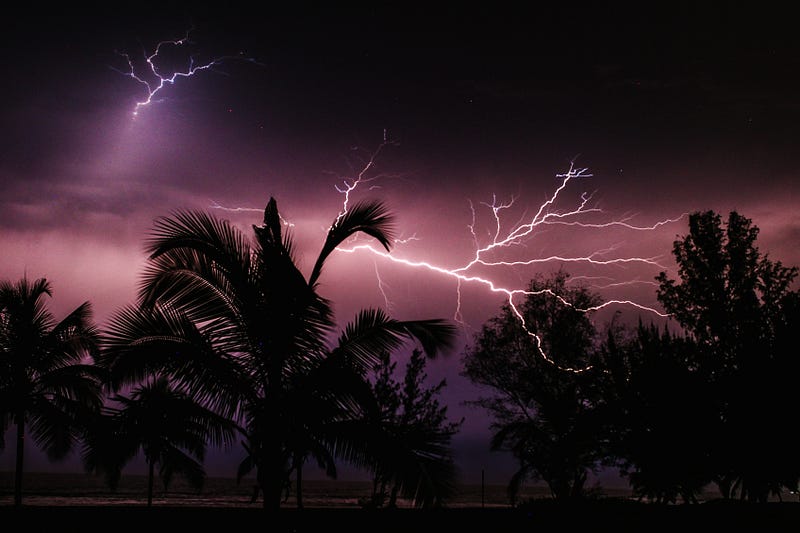Navigating the Century of Storms: Adapting to Climate Extremes
Written on
Chapter 1: The New Normal of Weather Extremes
It's here, whether you've noticed or not. Be ready.

Photograph by Bethany Laird on Unsplash
This morning, the temperature in western New York plummeted to -5°F, with the wind chill making it feel like -20°F. Tomorrow, we’ll experience a remarkable swing, approaching 50°F—a staggering 55-degree shift within just 24 hours.
Not long ago, such fluctuations were unheard of. Now, this kind of weather has become commonplace as we adjust to winters that are unlike anything we've faced before. Just last month, while 48 individuals tragically lost their lives in a severe snowstorm in Buffalo, only 60 miles away, we recorded a mere 1.7 inches of snow compared to their 55 inches.
This narrative, which once seemed extraordinary, is now being echoed around the world. Previously lush grasslands are turning into arid deserts, strewn with the remains of native wildlife, and once-idyllic vacation spots are being ravaged by hurricanes.
We are all too familiar with this cycle. I could list countless instances from the past year in the U.S. alone, but the boundaries of nations mean little when it comes to weather systems, polar vortexes, typhoons, torrential rains, and devastating droughts.
However, why dwell on the grim details? For many, these tragedies are no longer shocking news, especially for those directly affected. Complacency poses a significant hurdle as we confront this once-unimaginable destruction. It seems we are beginning to take these realities for granted.
I have previously noted how my area can be seen as a climate refuge—characterized by sufficient elevation and water resources, making it less vulnerable to catastrophic weather events. It’s a potential haven for those seeking safer ground.
But consider the fate of those 48 individuals in Buffalo, caught in a type of snowstorm that was once only a feature of remote mountain peaks—snow that cannot be cleared, ensnaring snowplows and emergency vehicles like a frozen trap.
Having spent over 50 years in Western New York, I have witnessed a significant transformation in our winters. I once believed we were relatively shielded from extreme weather, aside from the occasional snowstorm or rare ice storm.
Now, snowstorms have become increasingly infrequent, replaced by bizarre weather patterns. Ice storms have migrated southward, affecting places like Texas and the Deep South, as was evident earlier this week.
The pressing question is: how do we adapt our lives to a planet in constant change, where once-in-a-century storms are now annual occurrences? Honestly, there’s no straightforward answer, but there are proactive steps we can take.
First and foremost, stay alert. Natural disasters can strike anyone, regardless of wealth or privilege. You cannot escape weather that defies historical patterns. Your oceanfront estate in Florida or your hillside home in Southern California offers no immunity; they can vanish in mere moments.
Preparation is vital. Essential supplies such as blankets, a charged phone, food, water, and flares should be standard in every vehicle, tailored to different emergency scenarios. These items could have potentially saved lives in Buffalo.
For those in fire-prone regions, keep valuables packed in bags that can be quickly loaded into your car as flames approach. These actions have become necessary in today’s reality. You need a plan.
But what about long-term considerations? If you reside near the coast or in dense forests, it may be wise to contemplate relocating. Securing insurance will become increasingly challenging as these disasters escalate, meaning that personal savings may be the only option for maintaining property in high-risk areas.
Moreover, be prepared to face the possibility of losing everything.
As I enter my sixties, I have watched climate change unfold with a sense of foreboding throughout my life. I expected the repercussions to manifest sooner than the narratives propagated by oil companies.
We now know these corporations were aware of the impending crisis as early as the 1970s. They employed climate scientists to explore various scenarios, but the trajectory toward warming became undeniable. We are now experiencing the consequences years ahead of predictions.
Most of those scientists are now gone, silenced by legal teams and corporate executives. Their legacy will not be remembered kindly, as they chose to align with big oil.
This same industry recently reported record profits, as consumers grapple with soaring gas prices—an instance of price gouging that few politicians dare to label openly, fearing backlash in a society that thrives on fossil fuel revenue.
Ultimately, we are left to fend for ourselves. If you have the means, consider steps to reduce your carbon footprint and embrace a more sustainable lifestyle. However, this often requires a choice between significant expenditures or adopting a simpler, more adaptable way of living.
These are critical discussions we must engage in, and they reflect harsh realities we must confront. While humans are incredibly resilient, it becomes much harder to bounce back when you’ve unexpectedly lost everything or were unprepared for such a possibility.
This message isn't primarily directed at my generation. We are the ones who once dreamed of serene retirements in warm, safe places, untouched by crime, poverty, and severe weather. Those dreams are being dismantled daily, but at least we had the luxury of imagining them.
Unfortunately, we haven't provided the same options for our children and future generations.
It’s still important to embrace the Boy Scout motto: be prepared. This is the least we can do on an individual level. Relying on insurance companies and government support is not a viable strategy. We need to take personal action, informed by a new reality—one characterized by a century of storms.
If you're interested in writing, check out my newsletter, The Grasshopper. It covers topics related to writing techniques, lifestyle, inspiration, and creativity! I'm enjoying the process of crafting it weekly. To discover the origin of the name, read the first issue (don’t worry, there are many more to follow!). Oh, and it’s free!